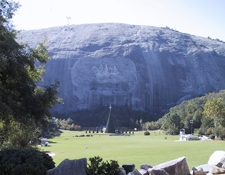landmarks & weather
 Atlanta's Landmarks
Atlanta's Landmarks
So, you're moving to a metropolitan area of more than 5 million people covering approximately 28 counties. As you might expect, there are some phrases that are "inside" terms for Atlanta's residents. We've defined them below, along with a few of Atlanta's landmarks that everyone should know.
Alpharetta Autobahn: Georgia 400, which runs from Buckhead to North Georgia cities like Alpharetta, Roswell and Cumming.
The Big Chicken: Often used as a landmark for directions, this 56-foot steel chicken structure at Kentucky Fried Chicken in Marietta has been located on the corner of Highway 120 and U.S. 41 since the 1960’s when it was a sign for Johnny Reb’s restaurant.
Buckhead: Home to the Governor’s Mansion, Buckhead is located north of Midtown and is considered on of Atlanta’s most affluent and elegant districts with its residential architecture, a growing number of imaginative commercial buildings and well-known shopping, dining and nightlife.
The Hooch: The Chattahoochee River begins in the southern edge of the Blue Ridge Mountains and provides drinking water and power in North Georgia and serves as a major source of recreation.
The Connector: The Downtown Connector is the interstate highway running through Downtown and is created by the merging of I-75 and I-85.
Little Five Points: Located south of Emory University eclectic area of restaurants and shops was named after the “five points” intersection between Moreland, Euclid and McLendon.
Georgia Dome: Located in Downtown Atlanta, this is the largest cable-supported dome stadium in the world and is host to numerous events.
I-285: This interstate makes a 60-mile north-south oval around Atlanta and is meant for through traffic to bypass the city.
ITP: “Inside the perimeter,” meaning inside the I-285 loop. This term refers to everything intown and urban about Atlanta. See also OTP and Perimeter.
King and Queen Buildings: The landmark King and Queen office towers have architectural crowns on the top of their buildings and are located at the Concourse Corporate Center off Hammond Drive in the Perimeter area.
Midtown: This energetic business district located north of downtown is known for its diverse residential living for singles and young professionals and is home to the Atlanta Botanical Gardens, Piedmont Park, Woodruff Arts Center and the Fox Theatre.
OTP: Short for “Outside the perimeter,” OTP is often used to refer to communities of Atlanta that are beyond the I-285 loop.
Peachtree Street: Named after an Indian path called Peachtree Creek, this street runs south and north through the center of town, becoming Peachtree Road as it passes through the Buckhead section.
Spaghetti Junction: This is the multi-layer of loops and bridges located where I-85 and I-285 intersect on the northeast side of the city.
Sweet Auburn: This historic district is located on Auburn Avenue and reflects the history and achievements of Atlanta and Black Americans through its collection of businesses, social organizations and churches.
Underground Atlanta: This historic shopping and restaurant district is located in and below Downtown Atlanta.
The Varsity: Established in 1928, this fast food establishment known for its hot dogs was the largest drive-through in the world before it was sized down when the Downtown Connector was built.
The Highlands: Named after its location at the intersection of Virginia and North Highlands Avenues, this is a popular area for urban professionals with its shopping district, trendy nightclub scene and unique boutiques.
Your Guide to Atlanta's seasons
Winter
Average Temperatures
- December: 45.4
- January: 42.7
- February: 46.7
Winters in Atlanta are generally mild thanks to the north Georgia Mountains, which keep the severely cold air at bay. The average temperatures tend to stay between the mid 30s and low 50's, although readings close to zero degrees are not unheard of during extreme cold spells. Atlanta also sees very little snowfall during the winter, averaging only 3 inches per year. While some days the cold weather might require dressing in layers, most of the time a sweater and coat are enough to keep you warm.
Atlanta Musts: Although the weather may be a little warmer than what you would expect for Christmas, Atlanta truly becomes a winder wonderland when celebrating the holidays. Whether it's the Atlanta Ballet's annual performance of "The Nutcracker" at the Fabulous Fox Theatre or the lighting of Macy's Great Tree at Lenox Square Mall, there is no shortage of holiday spirit in Atlanta during winter.
Spring
Average Temperatures
- March: 54.3
- April: 61.6
- May: 69.8
The cool winter weather give way to warmer spring temperatures in Atlanta much earlier that in other places. While morning lows are still regularly in the mid 40s, by May high temperatures are already starting to climb into the low 80s. In addition to the warm weather, spring also brings something else with it-thunderstorms. So while short-sleeves and jeans are usually a good combination in spring, you should also remember to pack an umbrella.
Atlanta Musts: With the weather becoming more pleasant and the flowers starting to bloom, spring is a great season for outdoor activities. One event that always draws a crowd is the Atlanta Dogwood Festival. Held each April in Midtown's Piedmont park, the outdoor celebration of arts and entertainment is considered the official start of spring in Atlanta.
Summer
Average Temperatures
- June: 76.8
- July: 80.0
- August: 78.9
Anyone who has spent time in Atlanta during the summer can tell why the city is often called "Hotlanta." With average high temperatures in the summer ranging from the high 80s to the low 90s, and the humidity regularly exceeding 90 percent, looking for ways to keep cool is a summer tradition. When going out into the summer heat, your best bet is to wear thin clothing such as T-shirts, tank tops and shorts. You also might want to keep a swimsuit handy for those lazy days by the pool.
Atlanta Musts: There are plenty of things to do in Atlanta that take advantage of the hot, yet beautiful, summer weather. One activity on every resident and tourist's to-do list is the Lasershow Spectacular performed nightly on the Memorial Lawn at Stone Mountain Park. For those who love to run, Atlanta holds the Peachtree Road Race, the world's largest 10K road race, every Fourth of July.
Fall
Average Temperatures
- September: 73.3
- October: 62.8
- November: 53.4
Autumn is perhaps the most pleasant season in Atlanta. Coming off the heels of intense summer heat, autumn temperatures are much cooler, with early morning lows in the 40s and afternoon highs in the 60s. The humidity is also much lower that the summer months. With such a moderate climate, you are usually safe dressing in pants and long-sleeves. However, given that mornings and nights can be very cool, bringing a jacket with you might be a good idea.
ATLANTA MUSTS: When you mention autumn around many people, they immediately think of one thing- football. With the 1999 NFC Championship Falcons playing home games in the Georgia Dome throughout the season, there is no shortage of gridiron action in Atlanta. Or if you are into more intellectual pursuits, be sure to visit the new Georgia Aquarium, which displays over 500 different species of sea creatures, including the rare whale shark.


